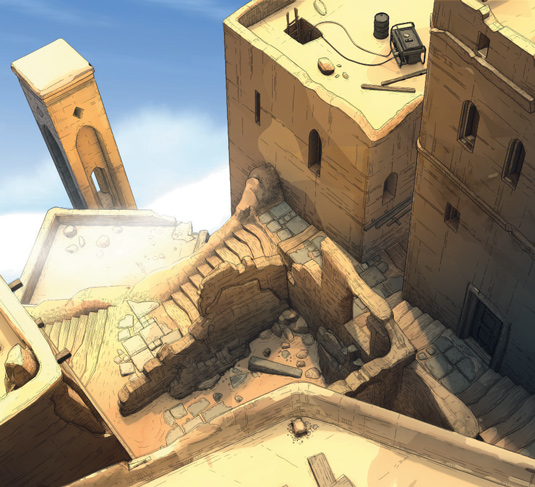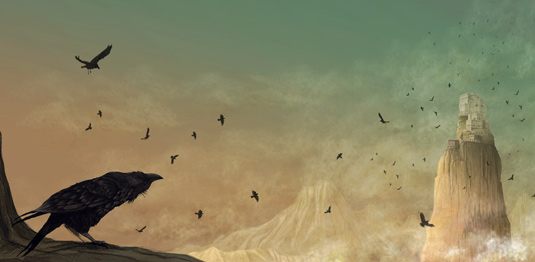Student animation achieves a 2D look using 3D software
Beautifully crafted, stylised animation Bet She'an presents a haunting metaphor for death.
Supinfocom students are no strangers to Creative Bloq and 3D World – in the past we've featured some impressive shorts from this top French school – and here we are showcasing another outstanding short, Bet She'an. We caught up with art director Julien Soler, director Bastien Letoile and technical director David Calvet to find out more about the work that went into this highly stylised piece.
"In the citadel of Bet She'an, lost in the high clouds of the sky, humans are progressively morphing into crows," says Calvet. "In this metaphor for death, we follow a man who decides to leave a trace of his dwindling race. He's sculpting a gigantic man in the rock before he himself turns into a bird."
Art director Soler adds, "The visual references for Bet She'an came from the Middle East, the fertile crescent where the first humans built cities and early civilisations: from Jordan, Yemen and Uzbekistan for their dryness and their architecture, the ruins of Petra, and Morocco for the ksar Aït-Ben-Haddou."
Creating a visual style
From the start of the project, the team knew they wanted to stay close to the style of graphic novels. "Our main references were Hugo Pratt, Sergio Toppi and Moebius: three of the greatest modern graphic novelists. Their line is mastered with great precision and sensitivity," says Calvet.
Bet She'an art director Soler was responsible for choosing every aspect of the visuals, from the amphoras and the architecture – which gives the city its distinct look – to choosing colours, lights, and working on shot composition.
"I was also the designer for all the characters," he says. "It was interesting to create the mix of human and crow anatomy; we drew lots of characters, mainly silhouettes, to discover which morph would have the credibility we needed."

Soler worked closely with the character modeller to keep the lines and the dynamic of each of the characters. The most difficult task was to draw over each shot to give them their own graphic style and also the character's UVs.
"We started on a graphics tablet but cross-hatching on that was a pain, there was a lag when making fast strokes," explains Soler. "So we moved to a lightbox and Rotring pen to get this particular handmade style. It was perfect but, with more than 80 shots to hatch, the work was very arduous – I spent days and days bending over my desk to finish this on time."
For the production, the team developed a notable way to achieve hair and feathers. "The rendering node for Hair Farm proved problematic, and we were forced to bake the modelling and the animation of all Hair Farm simulated hair and feather systems," says Calter. "This way we could render our scenes on any computer without using the Hair Farm plug-in. It was tedious but effective."
Heavy load
The rendering pipeline for the film was very heavy, according to Calter. "We started with the idea of a 2D illustration, and the watercolour style we chose presented a challenge. There is no clear way to achieve this effect easily in 3D.
"Our 2D artists were already busy, our art director was working on hatching the shots and the characters, and our matte painter was working on skies and 2D effects such as smoke and wind, so we decided to find a procedural way to achieve those 2D watercolour effects from our 3D models. We started research on two sides: one branch was to get an expressive, non-realistic render in 3D, and the other was to get 2D texture effects and 2D aspects through 2D filters.
"The final rendering pipeline was made of 12 passes, two of which were very important – one was to give an expressive render and the second was calculated from the first one to get a 2D texture effect."

After that, the team did a series of passes in V-Ray, including Lighting, Global Illumination, Shadow, Occlusion, Specular, Falloff and Toon. They also did passes for the cross-hatching, ID and masking.
The first pass we created in V-Ray was very interesting,” says Calvet, "because its way of calculating lights is close to the way humans see. It was easy to find the middle point between flat-coloured objects and a photorealistic render. The second pass was very simple: taking our last expressive render, we transferred the greyscale of the picture into a coloured multi-noise gradient. All of this was done in Screen Texture mode in an empty Max scene. By doing this as much as needed, we created a new texture every time.
The most important thing when creating a 2D/3D film is not to try to achieve the whole thing at once
"Finally the most important thing when creating a 2D/3D film is not to try to find a way to achieve the whole thing at once, nor to think that each shot has to be done as one piece. A hybrid workflow will give you the choice between different ways to get the same result, camera mapping, procedural textures, After Effects 3D layers and so on. In some instances we were creating textures, lighting and models for the whole film but sometimes it was just for one single shot."
When it came time to render, the team had to come up with a creative workaround. "To render we used V-Ray in a way we normally don’t," says David. "We used a V-Ray proxy to get an expressive render style – this was our colour basis. From this first render we needed some textures, so we plugged that back in 3ds Max and made a noisy gradient, which was applied in Screen mode on our first expressive pass. We also used Damian Nenow's cloud creation technique."
A collective creation
For a student team to create such a polished, sophisticated film in such a short space of time is very impressive. With such a heavy workload and complicated pipeline, was there anything they would have done differently in retrospect? "The rendering and hair and feather challenges meant we had to rush some bits of the animation, which was a shame, but deadlines were at our heels," says Calvet. "We all learned a lot during this project, mostly about production pipelines and post-production bugs.
"We had arguments about lighting, colours and ambience on some shots, everything wasn't fully locked down – to a degree, it's important to keep some aspects undecided before production starts. It wasn't a big problem, and finally it helped us all to see the same picture."
This article originally appeared in 3D World issue 178.
Liked this? Read these!
- The best 3D movies coming in 2014
- Discover what's next for Augmented Reality
- Download free textures: high resolution and ready to use now

Thank you for reading 5 articles this month* Join now for unlimited access
Enjoy your first month for just £1 / $1 / €1
*Read 5 free articles per month without a subscription

Join now for unlimited access
Try first month for just £1 / $1 / €1
Get the Creative Bloq Newsletter
Daily design news, reviews, how-tos and more, as picked by the editors.

The Creative Bloq team is made up of a group of art and design enthusiasts, and has changed and evolved since Creative Bloq began back in 2012. The current website team consists of eight full-time members of staff: Editor Georgia Coggan, Deputy Editor Rosie Hilder, Ecommerce Editor Beren Neale, Senior News Editor Daniel Piper, Editor, Digital Art and 3D Ian Dean, Tech Reviews Editor Erlingur Einarsson, Ecommerce Writer Beth Nicholls and Staff Writer Natalie Fear, as well as a roster of freelancers from around the world. The ImagineFX magazine team also pitch in, ensuring that content from leading digital art publication ImagineFX is represented on Creative Bloq.
